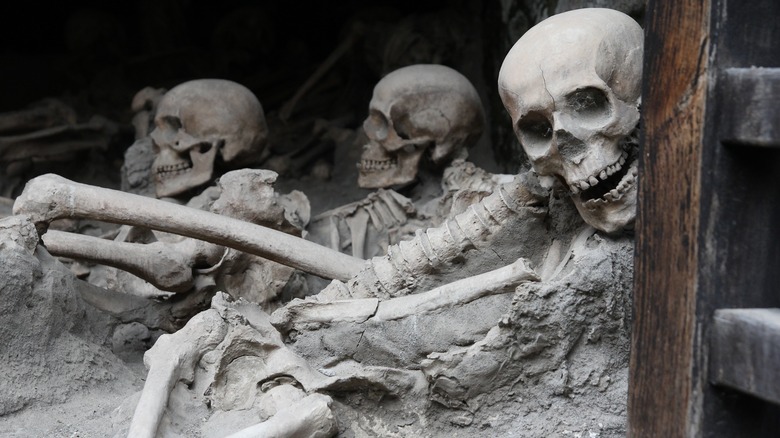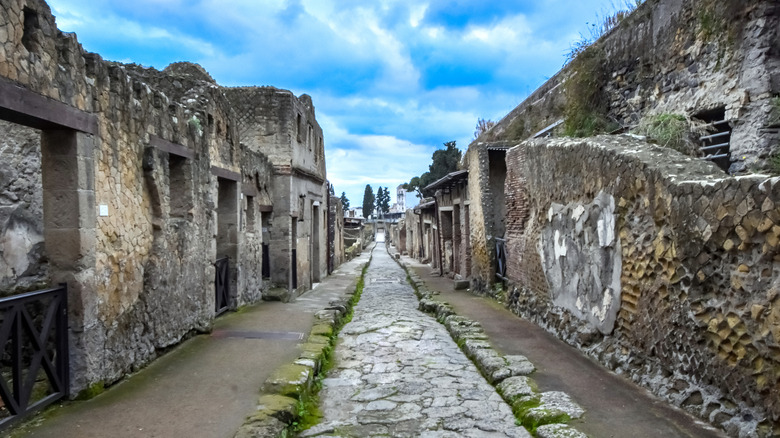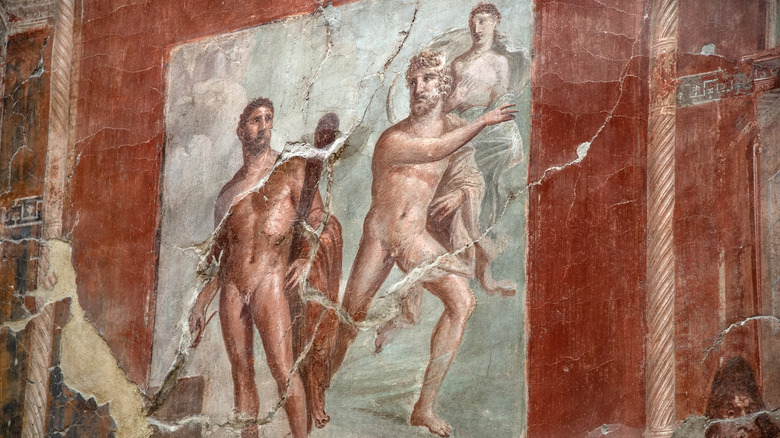What Happened To The Bodies From Herculaneum, Pompeii's Neighboring City?
At this point, talk of Pompeii life conjures images of destruction — white, contorted bodies frozen in agonized death poses from when Mt. Vesuvius erupted in 79 C.E. Those bodies aren't bodies at all, however — they're plaster casts. The ancient town's excavation director Giuseppe Fiorelli developed his ingenious plaster-pouring preservation method in 1863 while scraping away the layers of once-searing ash, lava, and pumice that instantly killed the 2,000 or so residents who refused to evacuate ahead of the eruption. The bones of about 100 people were made into plaster casts. But in the nearby town of Herculaneum, all of the remains are just bones.
Herculaneum often gets overlooked because of Pompeii's very dramatic, eye-catching plaster casts. But in some ways the city is even better than Pompeii for understanding the lives of the people of the time. Located a scant 10 miles from Pompeii and a bit closer to Vesuvius, Herculaneum and its inhabitants got caught in the same lethal 1,500-degree Fahrenheit pyroclastic flow — at its coolest — as their neighbors to the southeast. While Pompeii's remains were discovered in the late 16th century, Herculaneum's remnants weren't discovered until 1981 when archaeologists started finding skeletons on the area's beaches — presumably because it was the last place where residents could run from the eruption. At last count, about 300 skeletons have been uncovered. The rest remain below the surface.
Seaside resort turned well-preserved tomb
In the first century C.E., Herculaneum served much the same function that the southern Italian coast serves nowadays: A seaside getaway for the wealthy, replete with gorgeous estates, superb weather, sumptuous food and drink, and connected to a harbor that made for easy trade and transportation access. The Herculaneum Society says that the city was even favored by Julius Caesar's father-in-law, who owned property there. All of that got wiped away in a day in 79 C.E.
While we don't know many of Herculaneum's residents and visitors died when Mount Vesuvius erupted, we know that about 5,000 people lived in the town prior to its destruction. To date, about 300 skeletons have been uncovered. Unlike neighboring Pompeii, the volcanic gas that engulfed Herculaneum had a lower overall pyroclastic flow temperature, which better preserved the bones. Buildings, baths, sewers, and streets were also protected, as were highly perishable items like books, wooden furniture, vegetables, and even human waste. All of these were embedded in about 82 feet of mud that flowed into the city and sealed its remains shut along with the cooling ash, pumice, lava, etc.
Excavation started very recently in the 1980s, and most of the city has yet to be unearthed. Each new layer reveals more information. At present, most of the town's 300 skeletons were found near baths just outside of the city by the beach, left behind from when people tried to hide or escape.
Skeletons huddled together in public baths
While it's reasonable to conclude that many of Herculaneum's residents and visitors raced to boats to try and get off the Italian coast, most of the town's 296 skeletons were found huddled in a series of sheds. They were attached to public baths and typically used to store goods or boats. These people crammed themselves into the structures seeking shelter, and then died with Vesuvius' pyroclastic flow washed over them and flooded their hiding spots, called fornici. Fifty-nine skeletons were found on the actual beach, and only two were found offshore along with a sunken boat. While plenty of others might have escaped via sea or land, we've no way of knowing for sure. Unlike Pompeii, we don't have an eyewitness account from the day.
History and Archaeology Online says that the heat at the moment of death was so intense that bones and teeth simply snapped and shattered, respectively. The inside of skulls are still stained red from boiled blood and vaporized tissue. The skeletons have been left in the exact positions in which they were found — collapsed, crumpled, leaning against walls, sprawled out on the floor, and so forth. The Lancet says that four women amongst the dead aged 18 to 21 were pregnant, as evidenced by fetal bones. As Visit Pompeii explains, you can pay a visit and see these skeletons yourself. The rest of Herculaneum's dead still reside underfoot waiting to be uncovered.


